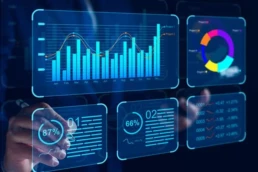Advanced analytics has brought forth the next spurt of growth for the Oil and Gas (O&G) industry. According to a report by Mckinsey, advanced analytics has the potential to transform organizations, and fundamental operating models and can yield returns as high as 30-50 times of investment.
The oil and Supply chain industry grapple through a wide range of complexities like ever-changing market conditions, fluctuating oil prices, demand imbalance, production operations, asset management, storage, and transportation issues all operate as stumbling block. Moreover, with various vendors and a vast extensive partner ecosystem, multiple silos emerge across the supply chain. They can influence visibility, efficiency, and service standards, and act as a barrier to supply chain collaboration.
Supply Chain Analytics can bridge the glaring differences and synchronize diverse functions across the upstream, midstream, and downstream supply chain. From enhanced product transportation to retail trading, from asset management to procurement and storage, from traffic management to last mile optimization- the O&G supply chain embracing the data analytics can maximize operational efficiency, monetize novel opportunities, and can raise the performance bar overall.
Listed below are some use cases that demonstrate how data and analytics can bolster O&G supply chains.
Logistics, Transportation & Shipping
Ingestion of advanced logistics planning and analytical tools can assist capture real-time inventory at oil tank terminals, routing hazardous substances across challenging terrains, and optimizing loading processes. Furthermore, O&G analytics can help track freight movements, implement capacity management strategies, and enhance the order-management process. Organizations can use data and analytics to improve offshore operations, cost optimization, and reduce dead miles for effective logistic management.
Asset Management & Predictive Modelling
With old facilities and aging equipment, organizations confront challenges in sustaining asset reliability and integrity. Any failure or breakdown can have an impact on production and costs, and disrupt supply chain operations. O&G organizations can use real-time data, IoT, and GPS to rapidly trace and manage their valuable assets. Considering equipment as a gas compressor, analysing both current and historical data, engineers can forecast device performance based on equipment’s service life standards and malfunction situations. Wireless video streaming and data from IoT sensors can help establish a resilient and reliable infrastructure – keeping the wind farms, rigs, vessels, liquefaction sites, pipelines, etc. connected centrally and cost-effectively. O&G analytics solutions can help to manage asset maintenance, spare parts inventory, and maximize asset lifespan and performance.
Leverage Automation
Leveraging warehouse management analytics with integrated analytical solutions and RFID technology can help drive visibility, efficiency, and collaboration across the warehouse and distribution processes. Predictive and proactive analytics can be used to assist warehouse locations to maintain optimal stocks or even better anticipate shipping and stocking requirements for elevated customer experience. Analysing historical data sets in real-time can gauge the similarities in current orders profile and forecast the time and size of inbound and outbound inventory volume. The warehouse managers can use computer visuals and analytics dashboards to enable warehouse optimization planning, inventory rationalization, and move parts or equipment along the warehouse perimeter.
Strategic Risk Sensing
In the wake of the pandemic, O&G boardroom discussions have shifted towards supplier risk assessment and enabling transparency across the value chain. Organizations can leverage the power of intelligent analytics to qualify Oil Field Services and Equipment (OFSE) suppliers and ensure a resilient digital supply network. They can examine threats or black swan events by studying metrics and analyses such as vendor availability scores, compliance rates, defect rates, and other project economics. Data and analytics can also tackle inevitable cost escalation around strategic sourcing, spend analysis, category management, and performance management. Early detection of emerging strategic risks can help an organization detect last mile disruptions, and change its course of action, and improve operations.
Wrapping Up
Faced with constantly evolving business dynamics, global laws, and rigorous environmental rules, the oil and gas sector is under pressure to discover robust, sustainable, and cost-effective methods to operate. A resilient and flexible network, augmented with real-time data and analytical tools, can anticipate abnormalities and support a variety of O&G supply chain applications. Combining analytics with cutting-edge technologies such as Artificial Intelligence, Machine Learning, Augmented Reality, Robotic Process Automation, and the Internet of Things, Innover enables O&G companies to break down supply chain silos, improve decision-making speed, quality, and drive growth with new revenue streams. Want to know more contact us now!


